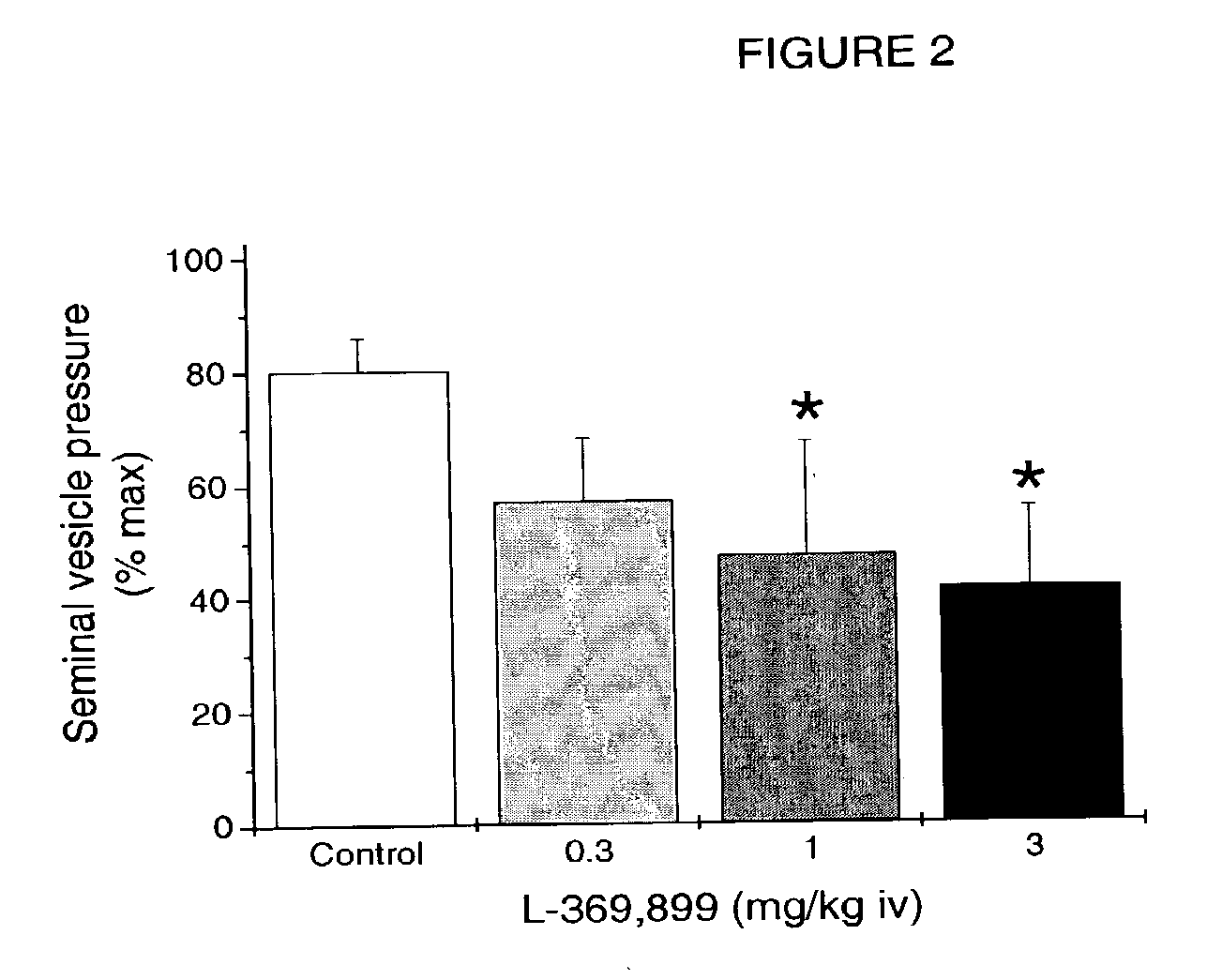Treatment of male sexual dysfunction
a treatment and male technology, applied in the field of male sexual dysfunction, can solve the problems of affecting both males and females, affecting sexual performance, and reducing self-esteem, and achieve the effect of high rna level in the myometrium
- Summary
- Abstract
- Description
- Claims
- Application Information
AI Technical Summary
Benefits of technology
Problems solved by technology
Method used
Image
Examples
example 1
Delaying Ejaculation in the Presence of a Selective Oxytocin Receptor Antagonist (L-368,899)
[0514]An oxytocin receptor antagonist L-368,899 significantly delayed p-chloroamphetamine (PCA)-induced ejaculation at oxytocin selective doses in anaesthetised rats (0.1-10 mgkg−1 sc). Ejaculation was delayed 140% (near maximal effect) at free plasma concentrations 5.4±1.5 nM (0.9×Ki OT, see FIG. 1)—it has been assumed that at this does any activity arises from antagonism of oxytocin receptors.
[0515]Erectogenic mechanisms were largely unaffected by oxytocin receptor blockade—the number of penile cups and flares was similar in control and oxytocin antagonist studies (see Table 1 below). Following a 1 mgkg−1 sc dose of L-368,899 (a dose that significantly delays ejaculation)-95% of PCA-induced erections resulted in penile cups compare to 94% in vehicle control groups and 61% of PCA-induced erections resulted in penile flares compare to 63% in vehicle control groups.
TABLE 1L-368,899Vehicle0.1 m...
example 2
Effect of a Selective Oxytocin Antagonist (L-368,899) on Seminal Vesicle Pressure in Anaesthetised Rats
[0518]L-368,899 significantly reduced splanchnic nerve-stimulated increases in seminal vesicle pressure in anaesthetised rats (1-3 mgkg−1 iv). Seminal vesicle contraction is essential for emission and the seminal fluid delivered into the prostatic urethra is thought to trigger ejaculation. Oxytocin has direct contractile effects on mammalian seminal vesicles and may additionally have a neuromodulator role influencing sympathetic innervation during ejaculation. In this study seminal vesicle contraction was reduced by 41% after a 1 mgkg−1 bolus injection (see FIG. 2 below). Preliminary studies suggest that the free plasma concentration for L-368,899 achieved after a 1.0 mgkg−1 iv injection is approximately 60 nM-based on literature PK and protein plasma binding.
[0519]The data suggests that oxytocin is released during splanchnic nerve stimulation and that the peptide plays a physiolog...
example 3
Effect of a Selective Oxytocin Antagonist (L-368,899) on Copulatory Behaviour in Rats
[0520]L-368,899 has no effect on copulatory behaviour in sexually-experienced rats at doses upto 10 mgkg−1 sc. Rodent copulatory behaviour is characterised by a series of mounts, with and without vaginal insertion (50-80% of mounts result in intromission [vaginal penetration]) and ejaculation occurs after 6 to 12 intromissions. Each intromission lasts a matter of seconds—it is not possible to quantify intromission length i.e. intravaginal latency. The effect of L-368,899 was assessed on a number of copulatory parameters (see above). We have focused copulatory efficiency as a measure that summarises vaginal penetration.
[0521]There were no effects of L-368,899 on copulatory efficiency at any of the doses tested (0.05-10 mgkg−1 sc, see Table 2 below). Preliminary pharmacokinetic studies suggest that 30 minutes after a 1 mgkg−1 sc and a 10 mgkg−1 sc injection, a free plasma concentration of 4.5 nM and 4...
PUM
| Property | Measurement | Unit |
|---|---|---|
| time | aaaaa | aaaaa |
| time | aaaaa | aaaaa |
| pH | aaaaa | aaaaa |
Abstract
Description
Claims
Application Information
 Login to View More
Login to View More - R&D
- Intellectual Property
- Life Sciences
- Materials
- Tech Scout
- Unparalleled Data Quality
- Higher Quality Content
- 60% Fewer Hallucinations
Browse by: Latest US Patents, China's latest patents, Technical Efficacy Thesaurus, Application Domain, Technology Topic, Popular Technical Reports.
© 2025 PatSnap. All rights reserved.Legal|Privacy policy|Modern Slavery Act Transparency Statement|Sitemap|About US| Contact US: help@patsnap.com



